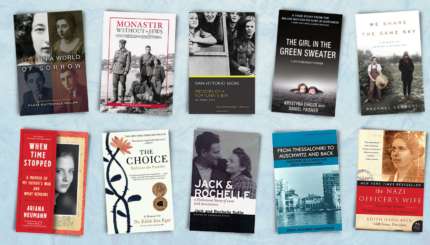Reprinted with permission from Indelible Shadows: Film and the Holocaust, third edition (Cambridge University Press).
Filmmakers and film critics confronting the Holocaust face a daunting task–finding an appropriate language for that which is mute or defies visualization. How can we lead a camera or pen to penetrate history and create art, as opposed to merely recording events? What are the formal as well as moral responsibilities if we are to understand and communicate the complexities of the Holocaust through its filmic representations?
Growing Genre
Such questions seem increasingly pressing, for the number of postwar films dealing with the Nazi era is steadily growing. I had seen at least 60 such films from around the world by 1980; when I completed the first edition of Indelible Shadows in 1982, another 20 had been produced; and by 1988 there were approximately 100 new films–40 fiction, 60 documentary–that merited inclusion.

Schindler’s List is arguably
the most famous Holocaust film.
My point of departure is therefore the growing body of cinematic work–primarily fiction–that illuminates, distorts, confronts, or reduces the Holocaust. Rather than prove a thesis, I wish to explore the degree to which these films manifest artistic as well as moral integrity. A number of central issues have emerged from this rapidly expanding body of films:

Help us keep Jewish knowledge accessible to millions of people around the world.
Your donation to My Jewish Learning fuels endless journeys of Jewish discovery. With your help, My Jewish Learning can continue to provide nonstop opportunities for learning, connection and growth.
1) the development of a suitable cinematic language for a unique and staggering subject. I contrast Hollywood’s realism and melodramatic conventions with the tense styles and dialectical montage of many European films, as well as present notable American exceptions;
2) narrative strategies such as the Jew as child; the Jew as wealthy, attractive, and assimilated; characters in hiding whose survival depends on performance; families doomed by legacies of guilt;
3) responses to Nazi atrocity, from political resistance to individual transformations of identity, to the guilt-ridden questions posed by contemporary German films;
4) a new form–neither documentary nor fiction–that shapes documentary material through a personal voice. Here, attention is paid to the films made by survivors, their children, and especially to the works of Marcel Ophuls.
Moral Issues
A major question is how certain cinematic devices express or evade the moral issues inherent in the subject. For example, how is Alain Resnais’s tracking camera in Night and Fog involved in moral investigation? In what ways does editing not only shape but embody the very content of The Pawnbroker or The Memory of Justice? And to what degree can montage be manipulative?
On a national scale, what change in attitude, if any, is implied by the sudden surge in the early ’70s of French films dealing with deportation and collaboration? What about the increasing number of German films that are finally turning their lenses onto the Nazi era? Whether the film is a dark comedy like Ernst Lubitsch’s To Be or Not to Be or an enlightening drama like Andrzej Munk’s Passenger, these works suggest both the possibilities and limitations of non-documentary approaches to World War II, especially the ghetto and concentration camp experience.
Defining “Holocaust”
The term “Holocaust” requires definition, for popular usage has particularized it from a general idea of disaster to the brutal and massive devastation practiced by the Nazis during World War II. I have chosen to use the word in this latter sense, and more precisely to refer to the genocide of European Jewry. For unlike their fellow victims of the Nazis–such as political opponents, Gypsies, and homosexuals–Jews were stripped not only of life and freedom, but of an entire culture that flourished throughout Eastern Europe in the early 1930s.
As chronicled in Josh Waletzky’s superb documentary Image Before My Eyes (1980), Polish-Jewish civilization was highly developed between the wars and included experimental education (a Montessori school in Vilna), progressive politics (the Bund, a Jewish Socialist party), and ripe artistic movements (Yiddish writers’ groups like “Di Khalyastre”). The Nazis’ avowed intention was not merely to annihilate the Jews, but to wipe their traces from history, and to destroy the very notion that a Jew was a human being.
Even within the concentration camps, the Nazis developed a hierarchy among inmates; political prisoners were enemies, but Jews were insects. Hitler declared, “Anti-Semitism is a form of de-lousing… a matter of sanitation.” Among the female inmates in Auschwitz, for instance, only the Jewish women’s heads were shaved.
Who “Owns” the Holocaust?
One of the dangers inherent in my argument, however, is the assumption that the Holocaust “belongs” to–or is the domain of–one set of victims more than another. Does the Holocaust belong to the survivors? To those who were killed during World War II? To those who died in concentration camps or ghettos? To the Jews who were the main targets of the Nazis? To all Jews today?
Some individuals claim the Holocaust as a personal tragedy. Many Jews claim it as a religious one. And then there are those who had no direct experience of the Holocaust but feel transformed by learning of its cruelty and mass indifference–as well as of resistance and survival.
And to whom do the dead “belong”? The ending of Just a Gigolo (1979), an otherwise negligible British film, presents a chilling image of appropriation: a bumbling young man (David Bowie) with no interest in politics is accidentally killed in a street fight between a Nazi group and its adversaries. The Nazi leader (David Hemmings, who also directed the film) takes the corpse, dresses it in the brown-shirted uniform of the SA, and has the young “hero” displayed and buried as a Nazi.
How many of the dead are likewise unable to defend themselves from the post-factum appropriation of groups who claim the Holocaust as theirs?


